最新最全少儿英语公开课的教案完整版
幼儿园英语公开课教案(7篇)

幼儿园英语公开课教案幼儿园英语公开课教案(7篇)作为一名教学工作者,常常要写一份优秀的教案,教案是教材及大纲与课堂教学的纽带和桥梁。
那么应当如何写教案呢?下面是小编精心整理的幼儿园英语公开课教案,供大家参考借鉴,希望可以帮助到有需要的朋友。
幼儿园英语公开课教案1Teaching aims:1 ew word :bread ausage milk coffee2 Revisio :little car,milk3 What day i today ? How are you ? How old are you ?Teaching aids:icture ag reorder musicTeaching te :te 1:GREetingsT:Cla egin,stand up!S:Stand u !stand u !I tand u !T:Good morning oy and girl !S:Good morning Mi Jiang !T:Sit dow lease !S:Sit down!sit dow !Isit dow !te 2 :warm uT:What day i today ?S:Today i Monday.T:How are you ?S:Fine ,Thank you and you ?T:I’m good !and how old are you ?S:I’m fivesix .(每个问提都分别叫幼儿回答或齐答)Ste 3 Revision全班小朋友一起读歌谣little car,milkSte 4 Lear ew wordsT:I’m very hungry.Do you have anything give me to eat ?S:NO ! O ! O !T:Rellay ?what’ that ?(旁边有一个小袋子装了些东西,突然发现,叫一名幼儿拿来看看,里面是否有吃的)T:Haa !what’ thi ? we call it read.S:Bread !T:Good !(带读,也可叫幼儿起来自己读,每个单词读5遍以上,而且要使幼儿都会认读。
少儿英语公开课教案lesson

少儿英语公开课教案Lesson 1-5一、Lesson 1: Greetings and IntroductionsObjective: Students will be able to introduce themselves and respond to greetings in English.Materials: Flashcards with pictures of different people, name tags Procedure:1. Begin the class with a warm-up activity. Ask students to introduce themselves in their native language and then translate it into English.2. Introduce yourself to the students and ask them to repeat after you: "Hello, my name is [name]. It's nice to meet you."3. Hand out name tags to each student and have them write their names on them.4. Practice different greetings such as "Good morning," "Good afternoon," and "Good evening." Ask students to respond accordingly.5. Play a game of charades with flashcards of different people. Students must act out the person on the flashcard without using words, and the rest of the class must guess who it is.6. Encourage students to practice introducing themselves to their peers and ask questions to get to know each other better.二、Lesson 2: ColorsObjective: Students will be able to name and recognize different colors in English.Materials: Flashcards with colors, color wheel, crayons and paper Procedure:1. Begin the class asking students to name the colors of the objects in the classroom.2. Introduce the color wheel and go through each color, saying the English word and asking students to repeat after you.3. Hand out flashcards with colors on them and have students match the flashcard to the correct color on the color wheel.4. Give each student a piece of paper and crayons, and ask them to drawa picture using the colors they have learned.5. Encourage students to practice naming colors in English and ask them to find objects in the classroom that match the colors on their flashcards.三、Lesson 3: Numbers 1-10Objective: Students will be able to count from 1 to 10 in English. Materials: Number flashcards, objects to count (e.g., buttons, coins) Procedure:1. Begin the class asking students to count in their native language.2. Introduce the numbers 1-10 in English and have students repeat after you.3. Hand out number flashcards and have students match the number to the correct number of objects.4. Practice counting objects in the classroom, such as buttons, coins, orchrs.5. Play a game of "Simon Says" where the teacher says a number, and students must touch that number of objects.6. Encourage students to practice counting in English and ask them to find objects in the classroom to count.四、Lesson 4: AlphabetObjective: Students will be able to recognize and name the letters of the English alphabet.Materials: Alphabet flashcards, alphabet chartProcedure:1. Begin the class singing the "Alphabet Song" to familiarize students with the letters of the alphabet.2. Introduce each letter of the alphabet using flashcards and have students repeat after you.3. Hang an alphabet chart on the wall and point to each letter, asking students to name it.4. Practice tracing the letters of the alphabet with your finger or a pointer, and have students follow along.5. Play a game of "Memory" with alphabet flashcards. Place the flashcards face down on the table, and students must flip over two cards at a time to find matching letters.6. Encourage students to practice naming the letters of the alphabet inEnglish and ask them to find objects in the classroom that start with each letter.五、Lesson 5: Simple SentencesObjective: Students will be able to construct and understand simple sentences in English.Materials: Flashcards with pictures, sentence stripsProcedure:1. Begin the class asking students to form simple sentences in their native language.2. Introduce the concept of simple sentences in English, explning that a simple sentence consists of a subject, verb, and object.3. Hand out flashcards with pictures on them and have students create a simple sentence using the words "I," "like," and "ice cream."4. Practice using different subjects and verbs to create simple sentences, such as "She," "likes," and "dancing."5. Give each student a sentence strip with a simple sentence on it, and ask them to find the subject,六、Lesson 6: Family and FriendsObjective: Students will be able to name family members and friends in English.Materials: Flashcards with family and friend pictures, family tree diagram Procedure:1. Begin the class asking students to name their family members and friends in their native language.2. Introduce the names of family members and friends in English, such as mother, father, sister, brother, friend, etc.3. Hand out flashcards with family and friend pictures on them and have students match the flashcard to the correct name.4. Create a family tree diagram on the board or a large sheet of paper, and ask students to identify and label their family members and friends.5. Practice asking and answering questions about family and friends, such as "Do you have a brother?" or "What is your mother's name?"6. Encourage students to practice naming family members and friends in English and ask them to share information about their family and friends with their peers.七、Lesson 7: AnimalsObjective: Students will be able to name and describe different animals in English.Materials: Flashcards with animal pictures, animal sounds chart Procedure:1. Begin the class asking students to name animals in their native language.2. Introduce the names of different animals in English, showing them the flashcards with animal pictures on them.3. Practice making the sounds that each animal makes, and have students imitate the sounds.4. Hand out an animal sounds chart and ask students to circle the animal sounds they hear.5. Play a game of charades with animal flashcards. Students must act out the animal without using words, and the rest of the class must guess which animal it is.6. Encourage students to practice naming and describing animals in English and ask them to find pictures of their favorite animals to bring to class.八、Lesson 8: Food and DrinkObjective: Students will be able to name and describe different foods and drinks in English.Materials: Flashcards with food and drink pictures, food and drink menu Procedure:1. Begin the class asking students to name foods and drinks in their native language.2. Introduce the names of different foods and drinks in English, showing them the flashcards with food and drink pictures on them.3. Practice ordering food and drinks in English, using phrases such as "I would like," "please," and "thank you."4. Hand out a food and drink menu and ask students to circle the itemsthey would like to order.5. Play a game of "Memory" with food and drink flashcards. Place the flashcards face down on the table, and students must flip over two cards at a time to find matching items.6. Encourage students to practice naming and describing foods and drinks in English and ask them to bring a picture of their favorite food or drink to class.九、Lesson 9: ClothingObjective: Students will be able to name and describe different articles of clothing in English.Materials: Flashcards with clothing pictures, clothing sorting activity Procedure:1. Begin the class asking students to name articles of clothing in their native language.2. Introduce the names of different articles of clothing in English, showing them the flashcards with clothing pictures on them.3. Hand out a clothing sorting activity where students must match the clothing items to the correct category (e.g., tops, bottoms, shoes, accessories).4. Practice asking and answering questions about clothing, such as "What is your favorite color of shirt?" or "Do you like to wear jeans or shorts?"5. Play a game of charades with clothing flashcards. Students must act out the article of clothing without using words, and the rest of the class must guess which item it is.6. Encourage students to practice naming and describing articles of clothing in English and ask them to bring a picture of their favorite outfit to class.十、Lesson 10: Review and AssessmentObjective: Students will demonstrate their understanding of the concepts covered in the past ten lessons.Materials: Review worksheets, flashcards, assessment checklist Procedure:1. Begin the class reviewing the concepts covered in the past ten lessons, such as greetings, colors, numbers, alphabet, family and friends, animals, food and drink, clothing, and simple sentences.2. Hand out review worksheets where students must plete tasks related to the concepts learned, such as fill in the blank, matching, or crossword puzzles.3. Conduct a mini-ass十一、Lesson 11: Days of the WeekObjective: Students will be able to name and recognize the days of the week in English.Materials: Days of the week flashcards, calendarProcedure:1. Begin the class asking students to name the days of the week in their native language.2. Introduce the days of the week in English, showing them the flashcards with the days of the week on them.3. Hand out a calendar and ask students to circle the current day of the week.4. Practice reciting the days of the week in English, and have students repeat after you.5. Play a game of "Simon Says" where the teacher says a day of the week, and students must touch that day on the calendar.6. Encourage students to practice naming the days of the week in English and ask them to find objects in the classroom that represent each day. 十二、Lesson 12: Months and SeasonsObjective: Students will be able to name and recognize the months and seasons in English.Materials: Months and seasons flashcards, seasonal pictures Procedure:1. Begin the class asking students to name the months and seasons in their native language.2. Introduce the months and seasons in English, showing them the flashcards with the months and seasons on them.3. Hand out a calendar and ask students to circle the current month and season.4. Practice reciting the months and seasons in English, and have students repeat after you.5. Display seasonal pictures around the classroom, and ask students to identify the season each picture represents.6. Encourage students to practice naming the months and seasons in English and ask them to discuss their favorite season and why.十三、Lesson 13: TimeObjective: Students will be able to tell the time in English using simple phrases.Materials: Clock diagram, digital clock, time phrases flashcards Procedure:1. Begin the class asking students to tell the time in their native language.2. Introduce the concept of time in English, explning that telling time involves hours and minutes.3. Hand out a clock diagram and ask students to identify the current time.4. Practice using simple time phrases in English, such as "It's 3 o'clock" or "It's 2:30."5. Display a digital clock in the classroom, and ask students to practicetelling the time aloud.6. Encourage students to practice telling the time in English and ask them to set a timer for a short duration, such as 5 minutes.十四、Lesson 14: Countries and ContinentsObjective: Students will be able to name and recognize different countries and continents in English.Materials: Maps of the world, flashcards with country and continent namesProcedure:1. Begin the class asking students to name some countries and continents in their native language.2. Introduce the names of different countries and continents in English, showing them the flashcards with country and continent names on them.3. Hand out maps of the world and ask students to locate and circle the countries and continents they have learned.4. Practice naming countries and continents in English, and have students repeat after you.5. Display a world map in the classroom, and ask students to point to the countries and continents they have learned.6. Encourage students to practice naming countries and continents in English and ask them to share something interesting about a country or continent they have learned.十五、Lesson 15: Review and AssessmentObjective: Students will demonstrate their understanding of the concepts covered in the past fifteen lessons.Materials: Review worksheets, flashcards, assessment checklist Procedure:1. Begin the class reviewing the concepts covered in the past fifteen lessons, such as greetings, colors, numbers, alphabet, family and friends, animals, food and drink, clothing, days of the week, months and seasons, time, countries and continents, and simple sentences.2. Hand out review worksheets where students must plete tasks related to the concepts learned, such as fill in the blank, matching, or crossword puzzles.3. Conduct a mini-assessment to evaluate students' understanding of the concepts covered. This can be done through a written or oral assessment, depending on the students' level.4. Provide feedback and encouragement to students based on their performance, and identify areas that need further practice.5. Plan additional activities or lessons to address any areas of weakness identified during the assessment.6. Celebrate the重点和难点解析一、Lesson 1: Greetings and Introductions重点:学习如何用英语进行问候和介绍。
少儿英语公开课教案课程

少儿英语公开课教案课程第一章:少儿英语教学理念与方法1.1 教学理念介绍少儿英语教学的目标和意义强调英语学习的趣味性和互动性强调培养学生的听说读写技能1.2 教学方法讲解直接教学、情境教学、游戏教学等方法示范如何设计有趣的英语教学活动讨论如何激发学生的学习兴趣和参与度第二章:少儿英语教学内容与资源2.1 教学内容介绍少儿英语教学的基本内容,包括字母、单词、句子、语法等示范如何设计适合不同年龄段学生的教学计划强调根据学生需求和兴趣调整教学内容的重要性2.2 教学资源介绍常用的教学资源,如教材、多媒体教具、游戏等示范如何利用教学资源创造互动和有趣的学习环境讨论如何选择合适的教学资源以提高教学效果第三章:少儿英语教学活动设计与实施3.1 教学活动设计介绍如何设计针对不同教学目标的教学活动示范如何结合歌曲、故事、游戏等元素进行教学强调考虑学生的年龄特点和学习风格的重要性3.2 教学活动实施介绍如何有效地组织和引导教学活动示范如何与学生互动,鼓励他们的参与和表达讨论如何评估学生的学习成果和提供反馈第四章:少儿英语教学策略与技巧4.1 教学策略介绍如何制定教学计划和目标示范如何运用不同的教学方法和技巧强调灵活运用教学策略以适应学生的不同需求4.2 教学技巧介绍如何有效地进行讲解、示范、引导等问题解答示范如何运用视觉、听觉、动手等多种教学手段讨论如何处理学生的学习困难和问题行为第五章:少儿英语教学评估与家长沟通5.1 教学评估介绍如何评估学生的学习成果和进展示范如何使用评价表、测试等工具进行评估强调及时反馈和鼓励学生的重要性5.2 家长沟通示范如何向家长报告学生的学习情况和问题讨论如何与家长合作,支持学生的英语学习。
第六章:少儿英语教学中的故事讲述与角色扮演6.1 故事讲述的重要性解释故事讲述在少儿英语教学中的作用,如提高听力、词汇和理解能力示范如何选择适合学生的英文故事素材强调通过故事讲述培养学生的语言表达和创造力6.2 角色扮演的技巧介绍角色扮演在英语教学中的应用,如增强口语表达和社交技能示范如何设计角色扮演活动,包括角色分配和对话练习讨论如何引导学生积极参与和利用角色扮演提高语言能力第七章:少儿英语教学中的歌曲与节奏7.1 歌曲在英语教学中的作用探讨歌曲如何提高学生的音标识别、节奏感和词汇记忆示范如何选择适合教学的英文歌曲和进行歌曲教学活动强调通过歌曲教学激发学生的兴趣和积极参与7.2 节奏与韵律的运用介绍如何在英语教学中利用节奏和韵律提高语言学习效果示范如何设计节奏练习和韵律游戏,如拍手、跳舞等讨论如何引导学生感受和创造节奏,增强语言节奏感第八章:少儿英语教学中的游戏与竞赛8.1 游戏在英语教学中的应用解释游戏在激发学生学习兴趣和动机中的作用示范如何设计适合不同教学目标的英语教学游戏强调游戏教学中的互动性和团队合作的重要性8.2 竞赛活动的组织与实施介绍如何组织英语竞赛活动,如拼写比赛、口语演讲等讨论如何通过竞赛活动提高学生的学习动力和自信心第九章:少儿英语教学中的文化导入与交流9.1 文化导入的重要性强调在英语教学中介绍和讨论目标语言的文化背景的重要性示范如何选择适合学生的文化素材,如节日、习俗等讨论如何通过文化导入提高学生的跨文化交流能力和理解力9.2 文化交流的实施方法介绍如何在英语教学中组织文化交流活动,如角色扮演、小组讨论等示范如何引导学生积极参与文化交流,培养开放和包容的态度强调在文化交流中尊重学生不同文化背景的重要性第十章:少儿英语教学中的课堂管理与合作学习10.1 课堂管理策略介绍有效的课堂管理策略,如建立规则、鼓励合作和积极反馈示范如何在英语课堂上维持秩序和营造积极的学习氛围讨论如何处理学生的行为问题和冲突,确保教学顺利进行10.2 合作学习的组织与指导解释合作学习在英语教学中的重要性,如提高沟通和团队协作能力示范如何设计合作学习活动,包括任务分配和小组互动强调在合作学习中引导学生有效沟通和相互支持的重要性第十一章:少儿英语教学中的科技应用11.1 科技在英语教学中的作用探讨如何利用科技提高教学效果和学生的学习兴趣示范使用多媒体教学资源、在线学习平台等科技工具强调在使用科技教学时保持教学目标和学生的需求为首要考虑11.2 科技应用的实践案例介绍具体的科技应用案例,如互动白板、应用程序、在线游戏等示范如何将科技融入教学活动,提高学生的参与度和互动性讨论如何选择合适的科技工具,以适应不同的教学环境和学生需求第十二章:少儿英语教学中的特殊需求学生12.1 特殊需求学生的特点与教学策略了解和学习特殊需求学生的特点和需求,如学习障碍、语言迟缓等示范针对特殊需求学生的教学策略和方法,如个性化教学、辅助工具等强调对特殊需求学生的耐心、理解和支持,营造包容和关爱的课堂氛围12.2 特殊需求学生的融合教育探讨如何将特殊需求学生融入普通课堂,实现真正的包容性教育示范如何在教学活动中兼顾特殊需求学生和其他学生的需求讨论如何与特殊需求学生的家长合作,共同制定教学计划和支持策略第十三章:少儿英语教学中的家庭教育与社区参与13.1 家庭教育的重要性与方法强调家庭教育在少儿英语学习中的重要作用和影响示范如何与家长合作,建立有效的家庭教育环境和策略讨论如何提供家长支持和资源,帮助他们有效地参与孩子的英语学习13.2 社区参与的推广与实践探讨如何利用社区资源,如图书馆、文化中心等,丰富少儿英语教学示范如何组织社区参与活动,如英语角、节日庆典等强调与社区合作的意义,提高学生的英语学习机会和经验第十四章:少儿英语教学中的持续专业发展14.1 持续专业发展的重要性强调教师在少儿英语教学中的持续学习和专业发展的重要性示范如何参与教育培训、研讨会等,提升教学知识和技能讨论如何与同行交流和分享经验,不断改进和提高教学质量14.2 持续专业发展的实践方法介绍具体的持续专业发展方法,如自主学习、行动研究等示范如何制定个人专业发展计划,平衡教学与学习的需求强调教师在持续专业发展中保持反思和探索的态度,追求卓越教学第十五章:少儿英语教学的综合评估与总结15.1 综合评估的方法与技巧探讨如何进行全面的评估,包括学生的学习成果、进步和表现示范如何使用评估工具和方法,如观察、问卷调查、学生作品等强调评估的目的是为了提高教学效果和学生学习,而非仅仅评价15.2 教学总结与改进介绍如何进行教学总结,反思教学过程中的优点和不足示范如何根据评估结果和反思,制定改进教学的计划和策略强调持续改进和适应教学的重要性,以满足学生的变化和学习需求重点和难点解析本文主要介绍了少儿英语公开课的教案内容,涵盖了教学理念与方法、教学内容与资源、教学活动设计与实施、教学策略与技巧、教学评估与家长沟通等多个方面。
幼儿园英语公开课教案

幼儿园英语公开课教案一、课程目标1. 学习并掌握基本的英语单词和句型。
2. 培养幼儿对英语的兴趣和好奇心。
3. 提高幼儿的口语表达能力和听力理解能力。
4. 培养幼儿的团队合作精神和积极参与意识。
二、教学内容1. 单词:学习颜色、动物、家庭成员、水果等基本词汇。
2. 句型:学习如何用英语介绍自己、询问他人以及表达喜好。
3. 歌曲:学习一首简单的英语歌曲,增强节奏感和语音感知。
三、教学方法1. 故事法:通过有趣的故事情节,引入并学习相关单词和句型。
2. 游戏法:设计各种互动游戏,让幼儿在游戏中自然地学习和运用英语。
3. 情境法:创设真实的日常情境,让幼儿模拟使用英语进行交流。
4. 歌曲法:通过学唱英语歌曲,提高幼儿的语音感知和节奏感。
四、教学准备1. 教具:准备相关单词的图片、卡片、玩具等。
2. 材料:准备颜色、动物、家庭成员、水果等实物或图片。
3. 音响设备:准备播放英语歌曲的音响或电脑。
五、教学过程1. 热身活动(5分钟):教师带领幼儿做简单的身体运动,如:拍手、跺脚等。
2. 引入新知识(10分钟):教师通过讲述一个有趣的故事,引入新单词和句型。
教师展示相关实物或图片,让幼儿猜测并说出对应的英语单词。
教师引导幼儿用所学句型进行自我介绍,如:“Hello, my name is.”3. 实践活动(10分钟):教师组织幼儿进行各种游戏,如:单词接龙、角色扮演等,让幼儿在游戏中运用所学英语。
教师设置情境,让幼儿模拟使用英语进行交流。
4. 复习巩固(5分钟):教师通过歌曲或游戏,让幼儿复习已学的单词和句型。
教师鼓励幼儿大胆开口说英语,提高口语表达能力。
5. 总结与拓展(5分钟):教师总结本节课所学内容,强调重点单词和句型。
教师鼓励幼儿在课后与家长分享所学英语,拓展学习空间。
教师提醒幼儿下节课的内容,激发学习兴趣。
六、教学评价1. 观察幼儿在课堂上的参与程度和积极性,评估他们对英语的兴趣和好奇心。
2. 通过课堂活动和游戏,评估幼儿对单词和句型的掌握情况。
少儿英语公开课教案lesson

少儿英语公开课教案Lesson 1-5教案简介:Lesson 1:Hello and Goode重点单词:hello, goode, good morning, good afternoon, good evening, how are you, I'm fine, thank you, what's your name, my name is语法点:问候语的使用对话:A: Hello, what's your name?B: My name is Tom. What's your name?A: My name is Lily.练习:用所学的问候语进行对话游戏:问候语接力赛Lesson 2:Introducing Yourself重点单词:self, introduce, name, age, school, class, teacher, friends语法点:介绍自己的方式对话:A: Hello, my name is Tom. I am 10 years old. I go to Starlight Elementary School. My teacher's name is Ms. Wang. What about you?B: Hello, my name is Lily. I am 9 years old. I go to Sunny Primary School. My teacher's name is Mrs. Zhang.练习:用所学的介绍自己的方式进行对话游戏:自我介绍接力赛Lesson 3:Family Members重点单词:family, mother, father, sister, brother, grandmother, grandfather, cousin语法点:家庭成员的称呼对话:A: This is my mother and father. They are teachers. This is my sister, and this is my brother. They are students.B: Nice to meet you! This is my grandmother and grandfather. They are retired. This is my cousin. She is a doctor.练习:用所学的家庭成员词汇进行对话游戏:家庭成员猜谜游戏Lesson 4:Days of the Week重点单词:Monday, Tuesday, Wednesday, Thursday, Friday, Saturday, Sunday, today, tomorrow, yesterday语法点:星期的表达方式对话:A: What day is today?B: Today is Friday. What day is tomorrow?A: Tomorrow is Saturday. What day was yesterday?B: Yesterday was Thursday.练习:用所学的星期的词汇进行对话游戏:星期卡牌游戏Lesson 5:Food and Drink重点单词:food, drink, water, milk, coffee, tea, bread, rice, fruit, cake语法点:食物和饮料的名称对话:A: What food do you like?B: I like rice and vegetables. What about you?A: I like cakes and fruits. What drink do you like?B: I like water and milk.练习:用所学的食物和饮料词汇进行对话游戏:食物和饮料猜谜游戏Lesson 6:Colors and Shapes重点单词:red, yellow, blue, green, orange, purple, circle, square, triangle, rectangle语法点:颜色的表达和形状的名称对话:A: What color is this?B: It's red. What color is that?A: That's yellow. What shape is this?B: This is a circle.练习:用所学的颜色和形状词汇进行对话游戏:颜色和形状配对游戏Lesson 7:Animals and Insects重点单词:animal, cat, dog, fish, bird, elephant, tiger, lion, bear, insect, ant, bee, butterfly语法点:动物和昆虫的名称对话:A: What animal do you like?B: I like dogs. What about you?A: I like cats. Do you like insects?B: Yes, I like butterflies.练习:用所学的动物和昆虫词汇进行对话游戏:动物和昆虫猜谜游戏Lesson 8:Clothing and Accessories重点单词:clothing, shirt, pants, dress, skirt, shoes, hat, bag, accessory, earring, necklace, bracelet语法点:服装和配饰的名称对话:A: What's your favorite clothing?B: I like shirts. What about you?A: I like skirts. What accessories do you like?B: I like earrings and bracelets.练习:用所学的服装和配饰词汇进行对话游戏:服装和配饰猜谜游戏Lesson 9:Numbers and Counting重点单词:number, one, two, three, four, five, six, seven, eight, nine, ten, count, hundred, thousand语法点:数字的读法和计数对话:A: Can you count from one to ten?B: Yes, I can. One, two, three, four, five, six, seven, eight, nine, ten.A: Good job! Can you count from one to a hundred?B: Sure, one hundred, two hundred, three hundred练习:用所学的数字进行计数练习游戏:数字接龙游戏Lesson 10:Review and Assessment重点单词:all, the, end, review, assessment, test, practice, correct, mistake, improve语法点:复习和评估的方法对话:A: We have learned a lot in this course. Let's have a review.B: Sure, let's review the important words and sentences we have learned. A: Great! Now, let's move on to the assessment part.B: Okay, I will do my best to answer the questions correctly.练习:进行课程复习和评估测试游戏:找出错误游戏重点和难点解析:1. 问候语的使用和家庭成员的称呼:这两个环节需要重点关注,因为它们是学习英语的基础,涉及到日常交流和基本的人际关系。
少儿英语公开课教案lesson
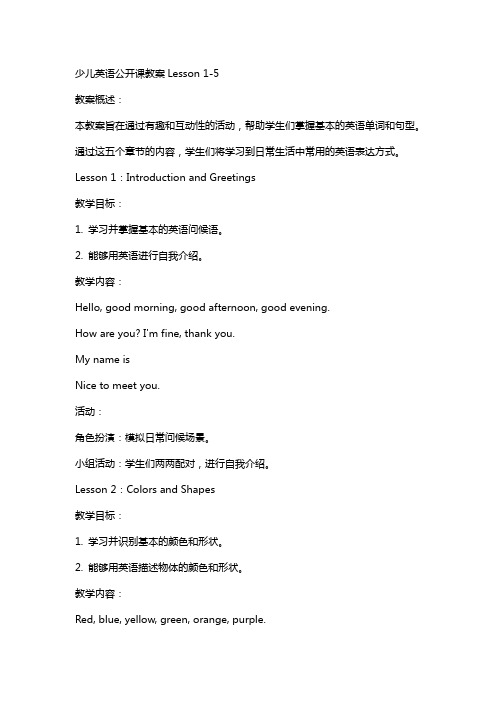
少儿英语公开课教案Lesson 1-5教案概述:本教案旨在通过有趣和互动性的活动,帮助学生们掌握基本的英语单词和句型。
通过这五个章节的内容,学生们将学习到日常生活中常用的英语表达方式。
Lesson 1:Introduction and Greetings教学目标:1. 学习并掌握基本的英语问候语。
2. 能够用英语进行自我介绍。
教学内容:Hello, good morning, good afternoon, good evening.How are you? I'm fine, thank you.My name isNice to meet you.活动:角色扮演:模拟日常问候场景。
小组活动:学生们两两配对,进行自我介绍。
Lesson 2:Colors and Shapes教学目标:1. 学习并识别基本的颜色和形状。
2. 能够用英语描述物体的颜色和形状。
教学内容:Red, blue, yellow, green, orange, purple.Circle, square, triangle, rectangle, ellipse.活动:颜色和形状的匹配游戏。
学生用英语描述桌面上的物体颜色和形状。
Lesson 3:Numbers and Counting教学目标:1. 学习并掌握基本的数字。
2. 能够用英语进行简单的计数。
教学内容:Numbers 1-10.Counting objects.活动:数字拼图游戏。
学生分组进行计数比赛。
Lesson 4:Family and Friends教学目标:1. 学习并掌握家庭成员和朋友的英语表达。
2. 能够用英语描述自己的家庭成员和朋友。
教学内容:Mother, father, sister, brother, grandmother, grandfather. Friend, friend's name.活动:家庭和朋友的图片匹配游戏。
幼儿英语公开课教案(精选5篇)
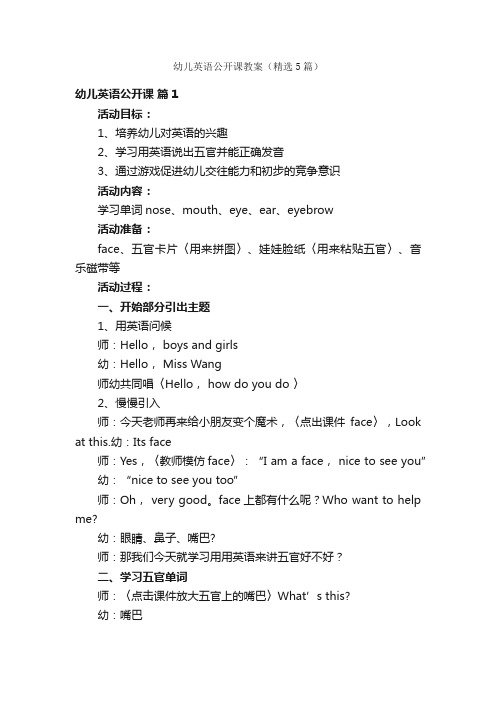
幼儿英语公开课教案(精选5篇)幼儿英语公开课篇1活动目标:1、培养幼儿对英语的兴趣2、学习用英语说出五官并能正确发音3、通过游戏促进幼儿交往能力和初步的竞争意识活动内容:学习单词nose、mouth、eye、ear、eyebrow活动准备:face、五官卡片〈用来拼图〉、娃娃脸纸〈用来粘贴五官〉、音乐磁带等活动过程:一、开始部分引出主题1、用英语问候师:Hello, boys and girls幼:Hello, Miss Wang师幼共同唱〈Hello, how do you do 〉2、慢慢引入师:今天老师再来给小朋友变个魔术,〈点出课件face〉,Look at this.幼:Its face师:Yes,〈教师模仿face〉:“I am a face,nice to see you”幼:“nice to see you too”师:Oh, very good。
face上都有什么呢?Who want to help me?幼:眼睛、鼻子、嘴巴?师:那我们今天就学习用用英语来讲五官好不好?二、学习五官单词师:〈点击课件放大五官上的嘴巴〉What’s this?幼:嘴巴师:oh,this is mouth,follow me “mouth”幼儿看老师口型跟读,向mouth打招呼“hello mouth”类似学习nose、eye、ear师:小朋友学的可真快,鼓励鼓励自己幼、good good very good.三、游戏比赛记忆单词师:小娃娃哭了?小朋友看发生了什么事?〈出示课件face五官消失〉原来娃娃的五官丢了,怎么办啊?幼儿积极讨论想办法。
我们都是一些有爱心的小朋友,那我们一起来帮娃娃找到五官,让她成为一个漂亮的娃娃吧。
〈教师讲解游戏玩法和规则,要求幼儿在桌子上找器官,找到的'用英语说出名字,在准备的没有五官的娃娃脸纸上组合一张完整的脸。
四、游戏指一指结束活动师:小朋友,小娃娃脸真漂亮,他们要回家了,先和他们说再见吧幼:goodbye师:下面老师要和小朋友做个游戏,游戏的名字叫:touch touch 教师找一名能力强的幼儿配合示范游戏〈教师用手请轻轻拍幼儿的手,一边说touch touch nose幼儿赶快用另一只手指在鼻子上,要求能够听到后,快速的指出相应的五官〉幼儿学会后可以自由找自己的好朋友玩这个游戏,教师鼓励帮助交往能力差的幼儿找到好朋友。
少儿英语公开课教案课程

少儿英语公开课教案课程第一章:少儿英语教学理念与方法1.1 教学理念介绍少儿英语教学的重要性和目的强调以学生为中心的教学理念强调培养学生的英语听说能力和兴趣1.2 教学方法讲解直接教学法、情景教学法和游戏教学法等方法举例说明如何在课堂上运用这些方法1.3 教学资源与工具介绍常用的教学资源,如教材、多媒体工具和在线资源演示如何使用这些资源进行教学第二章:少儿英语课程设计2.1 课程目标制定具体、可衡量的课程目标根据学生的年龄和水平确定目标2.2 课程内容设计课程主题和教学活动制定课程进度表和学习材料2.3 课程评估设计评估方法和评价标准定期进行评估和反馈第三章:少儿英语教学技巧与策略3.1 口语教学技巧讲解语音、语调和节奏的教授方法示范如何进行听力练习和口语表达3.2 阅读教学技巧介绍如何教授单词、句子和段落的阅读理解演示如何引导学生进行有效阅读3.3 写作教学技巧讲解写作的步骤和技巧提供写作指导和评价方法第四章:课堂管理技巧与策略讲解如何创造积极、愉快的课堂氛围4.2 学生行为管理介绍学生行为管理的方法和技巧示范如何处理学生不良行为4.3 个性化教学讲解如何根据学生的个性特点和学习需求进行教学示范如何调整教学策略以适应不同学生第五章:家长沟通与合作5.1 家长沟通的重要性强调与家长沟通的重要性介绍与家长沟通的方式和技巧5.2 家长参与与合作讲解如何鼓励家长参与孩子的英语学习介绍家长合作活动的组织和实施方法5.3 家长反馈与评价介绍如何收集家长反馈和评价示范如何根据家长反馈进行教学调整第六章:教学活动设计与实践6.1 教学活动的类型介绍小组活动、角色扮演、游戏等教学活动类型分析各种类型的教学活动对学生的益处6.2 教学活动案例提供具体的教学活动案例,如单词记忆游戏、情景对话等指导如何设计和实施这些教学活动6.3 教学活动的评估与反思讲解如何评估教学活动的效果示范如何进行教学活动的反思和调整第七章:文化差异与跨文化交流7.1 文化差异的认识介绍英语国家的文化特点和习俗强调了解文化差异对英语教学的重要性7.2 跨文化交流的技巧讲解如何教授跨文化交流的技巧示范如何在课堂上促进跨文化交流7.3 文化教育活动的设计介绍如何设计文化教育活动的内容和形式示范如何将文化教育融入英语教学第八章:特殊需求学生的教学策略8.1 特殊需求学生的识别与评估讲解如何识别和评估特殊需求学生介绍适应特殊需求学生的教学策略8.2 个性化教学策略强调个性化教学策略的重要性示范如何制定个性化教学计划8.3 辅助工具和资源的使用介绍辅助工具和资源,如图片、视频等指导如何使用这些工具和资源帮助特殊需求学生第九章:课堂观察与反思9.1 课堂观察的目的和方法介绍课堂观察的重要性和目的讲解如何进行有效的课堂观察9.2 观察结果的分析和反思强调分析观察结果的重要性示范如何根据观察结果进行教学反思和调整9.3 持续专业发展的计划强调持续专业发展的重要性介绍制定持续专业发展计划的方法和步骤第十章:课程总结与展望10.1 课程总结回顾整个课程的主要内容和知识点强调教学理念和方法的重要性10.2 教学成果的展示介绍如何展示教学成果,如学生作品、教学报告等示范如何评价和反思教学成果10.3 教学展望展望未来少儿英语教学的发展趋势强调教师在推动学生学习和发展中的关键作用重点解析本文教案主要针对少儿英语公开课的教学理念、方法、课程设计、教学技巧、课堂管理、家长沟通与合作、教学活动设计与实践、文化差异与跨文化交流、特殊需求学生的教学策略、课堂观察与反思以及课程总结与展望等方面进行了详细的阐述。
少儿英语教案模板(3篇)
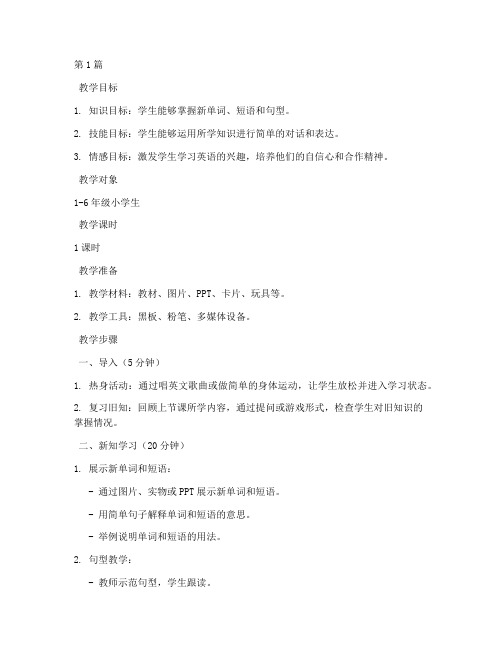
第1篇教学目标1. 知识目标:学生能够掌握新单词、短语和句型。
2. 技能目标:学生能够运用所学知识进行简单的对话和表达。
3. 情感目标:激发学生学习英语的兴趣,培养他们的自信心和合作精神。
教学对象1-6年级小学生教学课时1课时教学准备1. 教学材料:教材、图片、PPT、卡片、玩具等。
2. 教学工具:黑板、粉笔、多媒体设备。
教学步骤一、导入(5分钟)1. 热身活动:通过唱英文歌曲或做简单的身体运动,让学生放松并进入学习状态。
2. 复习旧知:回顾上节课所学内容,通过提问或游戏形式,检查学生对旧知识的掌握情况。
二、新知学习(20分钟)1. 展示新单词和短语:- 通过图片、实物或PPT展示新单词和短语。
- 用简单句子解释单词和短语的意思。
- 举例说明单词和短语的用法。
2. 句型教学:- 教师示范句型,学生跟读。
- 将学生分成小组,进行句型练习。
- 教师巡视指导,纠正发音和语法错误。
3. 情景模拟:- 创设一个简单的情景,让学生运用所学知识进行对话。
- 可以使用卡片、玩具等辅助道具。
三、巩固练习(15分钟)1. 游戏环节:- 设计与新课内容相关的游戏,如“找单词”、“单词接龙”等。
- 通过游戏,让学生在轻松愉快的氛围中巩固所学知识。
2. 小组活动:- 将学生分成小组,每组完成一个与新课内容相关的任务。
- 任务完成后,每组派代表进行展示。
四、总结与作业(5分钟)1. 总结:- 教师简要回顾本节课所学内容。
- 强调重点单词、短语和句型。
2. 作业布置:- 布置与新课内容相关的作业,如抄写单词、造句、情景对话等。
- 鼓励学生在家里与家长进行英语对话。
教学反思1. 教师在授课过程中要注意观察学生的反应,及时调整教学方法和进度。
2. 鼓励学生积极参与课堂活动,提高他们的学习兴趣和自信心。
3. 注重培养学生的英语思维习惯,提高他们的英语实际运用能力。
教案示例课题:My Family(我的家庭)教学目标:1. 学生能够掌握家庭相关词汇,如father, mother, brother, sister等。
小学英语优质公开课教案(精选17篇)
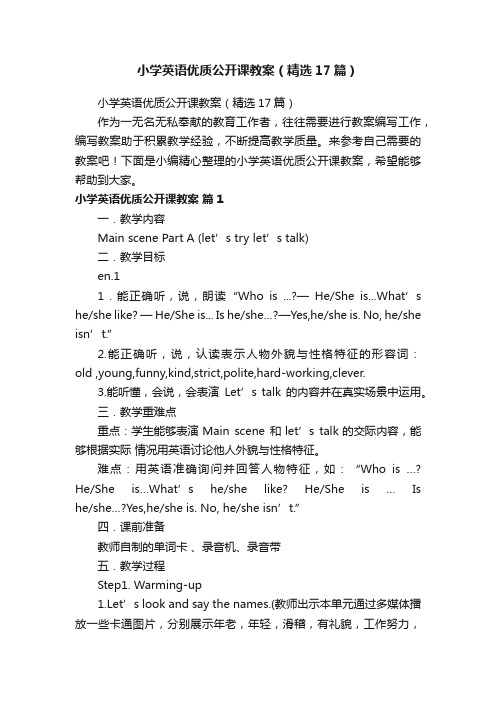
小学英语优质公开课教案(精选17篇)小学英语优质公开课教案(精选17篇)作为一无名无私奉献的教育工作者,往往需要进行教案编写工作,编写教案助于积累教学经验,不断提高教学质量。
来参考自己需要的教案吧!下面是小编精心整理的小学英语优质公开课教案,希望能够帮助到大家。
小学英语优质公开课教案篇1一.教学内容Main scene Part A (let’s try let’s talk)二.教学目标en.11.能正确听,说,朗读“Who is ...?—He/She is...What’s he/she like? —He/She is... Is he/she…?—Yes,he/she is. No, he/she isn’t.”2.能正确听,说,认读表示人物外貌与性格特征的形容词:old ,young,funny,kind,strict,polite,hard-working,clever.3.能听懂,会说,会表演Let’s talk 的内容并在真实场景中运用。
三.教学重难点重点:学生能够表演Main scene 和let’s talk的交际内容,能够根据实际情况用英语讨论他人外貌与性格特征。
难点:用英语准确询问并回答人物特征,如:“Who is …? He/She is…What’s he/she like? He/She is … Is he/she…?Yes,he/she is. No, he/she isn’t.”四.课前准备教师自制的单词卡、录音机、录音带五.教学过程Step1. Warming-up1.Let’s look and say the names.(教师出示本单元通过多媒体播放一些卡通图片,分别展示年老,年轻,滑稽,有礼貌,工作努力,聪明,严格等外貌与性格特征,让学生认读,说一说这是谁,怎么样。
)2.Let’s listen and sing”Who’s your teacher?”Step2. Presentationen.11.学习Main scene(1)出示Main scene中的部分教学挂图,让学生观察。
少儿英语公开课教案lesson

少儿英语公开课教案Lesson 1-5一、Lesson 1: Greetings and IntroductionsObjective:1. Students will be able to introduce themselves and greet others in English.2. Students will learn basic phrases for asking and responding to questions about their names, ages, and favorite colors.Materials:1. Flashcards with pictures of different colors2. Name tagsProcedure:1. Begin the lesson with a warm-up activity, such as a simple song or dance to get the students engaged.2. Introduce yourself and ask the students to introduce themselves. Model the correct phrases and pronunciation.3. Distribute name tags to the students and have them wear them for the duration of the lesson.4. Display the flashcards with pictures of different colors and ask the students to identify the colors.5. Practice asking and responding to questions about names, ages, and favorite colors. Encourage the students to ask each other these questions.6. Conduct a role-play activity where the students practice introducing themselves and asking questions to their classmates.7. End the lesson with a fun game, such as "Simon Says" using color names in English.二、Lesson 2: Alphabet RecognitionObjective:1. Students will be able to recognize and name the letters of the English alphabet.2. Students will learn the correct pronunciation of each letter. Materials:1. Large alphabet letters displayed on flashcards2. Worksheet with pictures of objects that start with each letter of the alphabetProcedure:1. Begin the lesson singing the "Alphabet Song" to familiarize the students with the letters of the alphabet.2. Display the large alphabet letters on flashcards and have the students repeat the letters and their pronunciations.3. Practice tracing the letters of the alphabet on a large whiteboard or blackboard.4. Hand out the worksheets and have the students circle the objects that start with each letter of the alphabet.5. Conduct a group activity where the students take turns naming objects that start with each letter of the alphabet.6. End the lesson with a fun game, such as "Memory Match" using alphabet letters as cards.三、Lesson 3: Numbers and CountingObjective:1. Students will be able to count from 1 to 20 in English.2. Students will learn to recognize and write numbers 1-20. Materials:1. Number flashcards2. Counters or small objects to represent numbersProcedure:1. Begin the lesson introducing the concept of numbers and counting.2. Display the number flashcards and have the students repeat the numbers and their pronunciations.3. Practice counting with the students, using counters or small objects to represent the numbers.4. Hand out worksheets with number lines and have the students fill in the missing numbers.5. Conduct a group activity where the students take turns counting objects in the classroom, such as chrs or desks.6. End the lesson with a fun game, such as "Number Memory" usingnumber cards.四、Lesson 4: Simple Sentences and QuestionsObjective:1. Students will be able to construct simple sentences in English.2. Students will learn to ask and answer questions using simple sentence structure.Materials:1. Flashcards with pictures of everyday objects2. Worksheet with sentences to pleteProcedure:1. Begin the lesson introducing the concept of simple sentences and questions.2. Display the flashcards with pictures of everyday objects and have the students name the objects.3. Practice constructing simple sentences using the objects, such as "This is a book" or "She has a pen."4. Introduce question words, such as "What is this?" or "Who has a pen?" and have the students ask and answer questions using simple sentence structure.5. Hand out the worksheets and have the students plete the sentences using the pictures provided.6. Conduct a group activity where the students take turns asking andanswering questions using simple sentence structure.7. End the lesson with a fun game, such as "Charades" using simple sentences as clues.五、Lesson 5: Days of the Week and MonthsObjective:1. Students will be able to name the days of the week and months in English.2. Students will learn the correct order of the days and months. Materials:1. Flashcards with pictures of the days of the六、Lesson 6: Colors and ShapesObjective:1. Students will be able to name and recognize different colors and shapes in English.2. Students will learn to describe objects using color and shape adjectives.Materials:1. Flashcards with pictures of different colors and shapes2. Colored objects or shapesProcedure:1. Begin the lesson reviewing the colors and shapes learned in previous lessons.have the students name them.3. Practice describing objects using color and shape adjectives, such as "The circle is red" or "The square is blue."4. Hand out colored objects or shapes and have the students practice describing them.5. Conduct a group activity where the students take turns finding objects in the classroom that match the given color or shape.6. End the lesson with a fun game, such as "Color and Shape Memory" using color and shape cards.七、Lesson 7: Animal Names and SoundsObjective:1. Students will be able to name and imitate the sounds of different animals in English.2. Students will learn to associate animal names with their corresponding sounds.Materials:1. Flashcards with pictures of different animals2.玩具动物声音Procedure:1. Begin the lesson introducing the concept of animal names and sounds.students name them.3. Play the toy animal sounds and have the students guess which animal it is.4. Practice imitating the sounds of different animals and associating them with their names, such as "The dog says 'Woof!'" or "The cat says 'Meow!'"5. Hand out small toy animals and have the students practice making their sounds.6. Conduct a group activity where the students take turns bringing out a toy animal and having the others guess its name and sound.7. End the lesson with a fun game, such as "Animal Charades" using animal names and sounds as clues.八、Lesson 8: Family and FriendsObjective:1. Students will be able to name and describe their family and friends in English.2. Students will learn to use possessive pronouns and adjectives to talk about their loved ones.Materials:1. Flashcards with pictures of family members and friends2. Worksheet with sentences to pleteProcedure:1. Begin the lesson introducing the concept of family and friends.2. Display the flashcards with pictures of family members and friends and have the students name them.3. Practice using possessive pronouns and adjectives to describe their family and friends, such as "This is my mother" or "She is my best friend."4. Hand out the worksheets and have the students plete the sentences using the pictures provided.5. Conduct a group activity where the students take turns sharing information about their family and friends.6. End the lesson with a fun game, such as "Guess Who?" using pictures of students' family members and friends as clues.九、Lesson 9: Actions and VerbsObjective:1. Students will be able to name and describe different actions and activities in English.2. Students will learn to use action words (verbs) to describe what people are doing.Materials:1. Flashcards with pictures of different actions and activities2. Action figures or dollsProcedure:1. Begin the lesson introducing the concept of actions and verbs.2. Display the flashcards with pictures of different actions and activities and have the students name them.3. Practice using action words (verbs) to describe what people are doing in each picture, such as "She is running" or "He is jumping."4. Hand out action figures or dolls and have the students practice acting out the actions and using the corresponding verbs.5. Conduct a group activity where the students take turns acting out actions and having the others guess what they are doing.6. End the lesson with a fun game, such as "Action Charades" using action words as clues.十、Lesson 10: Review and AssessmentObjective:1. Students will demonstrate their understanding of the concepts and skills learned throughout the course.2. Students will improve their speaking, listening, reading, and writing skills through a variety of review activities.Materials:1. Review worksheet with a variety of activities2. Assessment tools, such重点和难点解析一、Lesson 1: Greetings and Introductions重点关注环节:1. 学生自我介绍和问候他人的正确phrases 和发音。
学前班英语公开课教案(精编版)

学前班英语公开课教案(精编版)一、课程目标:1. 让学生初步了解英语的基本字母和发音。
2. 通过有趣的英语活动,激发学生学习英语的兴趣。
3. 培养学生的听说能力和团队协作精神。
二、教学内容:1. 学习字母A-G的发音和书写。
2. 学习简单的英语单词,如:apple, banana, cat, dog, elephant。
3. 通过歌曲、游戏等活动,让学生熟悉英语发音和节奏。
三、教学准备:1. 准备字母卡片A-G。
2. 准备单词卡片apple, banana, cat, dog, elephant。
3. 准备录音机和英语歌曲磁带。
4. 准备颜色笔和画纸,用于绘画活动。
四、教学过程:1. 热身活动(5分钟)教师带领学生唱英语歌曲,让学生放松心情,激发学习兴趣。
2. 字母学习(10分钟)教师出示字母卡片A-G,引导学生跟读,讲解字母的发音和书写。
3. 单词学习(10分钟)教师出示单词卡片,引导学生跟读,讲解单词的意思和发音。
4. 绘画活动(10分钟)教师引导学生用颜色笔和画纸绘制自己喜欢的英语单词,如:画一个苹果,并在旁边写上“apple”。
5. 总结与作业(5分钟)教师回顾本节课所学内容,布置作业:复习字母A-G和单词apple, banana, cat, dog, elephant。
五、教学评价:1. 观察学生在课堂上的参与程度,了解他们对英语学习的兴趣。
2. 评估学生在绘画活动中的表现,检验他们对英语单词的理解。
3. 课后收集学生作业,检查他们的复习效果。
六、教学内容:1. 学习字母H-L的发音和书写。
2. 学习简单的英语单词,如:hot dog, ice cream, jumps, laughter。
3. 通过情景剧等活动,让学生进一步熟悉英语表达。
七、教学准备:1. 准备字母卡片H-L。
2. 准备单词卡片hot dog, ice cream, jumps, laughter。
3. 准备录音机和英语情景剧剧本。
2024年幼儿园小班英语公开课标准教案

2024年幼儿园小班英语公开课标准教案一、教学内容本节课选自《幼儿英语》教材第一章,主题为“Hello, My Name Is”,详细内容包括:学习问候语、介绍自己名字以及简单自我介绍。
二、教学目标1. 让幼儿掌握基本问候语,如“Hello”、“Hi”等。
2. 培养幼儿用英语介绍自己名字能力。
3. 培养幼儿英语听说能力,激发学习英语兴趣。
三、教学难点与重点1. 教学难点:正确发音,用英语介绍自己名字。
2. 教学重点:掌握问候语,学会用英语进行简单自我介绍。
四、教具与学具准备1. 教具:卡片、挂图、玩具、小礼物等。
2. 学具:彩色笔、画纸、姓名贴纸等。
五、教学过程1. 实践情景引入(5分钟)教师扮演卡通人物,用英语向幼儿问好,引导幼儿模仿。
邀请幼儿上台,用英语进行问候,给予表扬和鼓励。
2. 例题讲解(15分钟)教师展示挂图,讲解问候语,如“Hello”、“Hi”等。
教师示范如何用英语介绍自己名字,如“My name is”。
3. 随堂练习(10分钟)分组进行问候语练习,让幼儿相互介绍自己名字。
教师巡回指导,纠正发音,给予鼓励。
4. 游戏环节(10分钟)“找朋友”游戏:幼儿用英语问候,找到自己好朋友。
“送礼物”环节:教师发放小礼物,幼儿用英语表示感谢。
教师邀请幼儿上台,展示所学内容。
全班幼儿一起用英语问候,展示自我介绍。
六、板书设计1. 问候语:Hello、Hi2. 自我介绍:My name is七、作业设计1. 作业题目:用英语介绍自己名字,并与家人分享所学内容。
2. 答案示例:Hello, my name is Tom. I'm happy to learn English.八、课后反思及拓展延伸1. 课后反思:关注幼儿在课堂上表现,解他们学习情况,及时调整教学方法。
2. 拓展延伸:鼓励幼儿在家庭、学校等场合,用英语进行问候和自我介绍,提高英语实际运用能力。
重点和难点解析1. 教学内容难易程度与幼儿认知水平;2. 教学过程中实践情景引入,以增强幼儿学习兴趣;3. 教学难点与重点针对性讲解;4. 板书设计简洁明;5. 作业设计针对性与实用性;6. 课后反思与拓展延伸实际操作。
少儿英语公开课教案课程

少儿英语公开课教案课程第一章:英语字母表的认识与学习1.1 教学目标让学生掌握英语字母表的26个字母,包括大小写。
让学生能够正确地拼读和书写字母。
培养学生对英语字母的兴趣和好奇心。
1.2 教学内容英语字母表的顺序和结构。
字母的大小写及其对应关系。
字母的拼读和书写方法。
1.3 教学活动字母表闪卡游戏:用闪卡方式展示字母,让学生快速认出大小写。
字母书写练习:让学生跟着老师的示范,书写字母。
字母拼读练习:让学生练习读出字母的音。
第二章:基本日常英语口语2.1 教学目标让学生掌握一些基本的日常英语口语词汇和表达。
让学生能够用英语进行简单的自我介绍和日常交流。
培养学生的口语表达能力和自信心。
2.2 教学内容日常英语口语词汇:如hello, good morning, good afternoon, good evening, how are you, my name is等。
自我介绍和日常交流的表达方式。
2.3 教学活动角色扮演:学生分组进行角色扮演,模拟日常交流场景。
口语练习:让学生练习用英语进行自我介绍。
小组活动:学生分组,用英语进行简单的对话交流。
第三章:简单英语句型的学习3.1 教学目标让学生掌握一些简单的英语句型,并能够灵活运用。
培养学生能够用英语进行简单的句子表达。
培养学生的语法意识和句子结构理解能力。
3.2 教学内容简单英语句型:如主语+谓语+宾语的句型。
常用动词和形容词的词义和用法。
3.3 教学活动句子接龙游戏:学生轮流构建句子,下一个学生需要接上前一个学生的句子。
形容词和动词卡片游戏:学生通过抽卡片,用卡片上的形容词和动词构建句子。
句子仿写练习:让学生根据给定的句型,自己构思句子并书写。
第四章:英语颜色和数字的学习4.1 教学目标让学生掌握基本的英语颜色词汇和数字词汇。
培养学生能够用英语正确表达颜色和数字。
培养学生的观察力和记忆力。
4.2 教学内容颜色词汇:如red, blue, yellow, green, black, white等。
剑桥少儿英语教案(全)
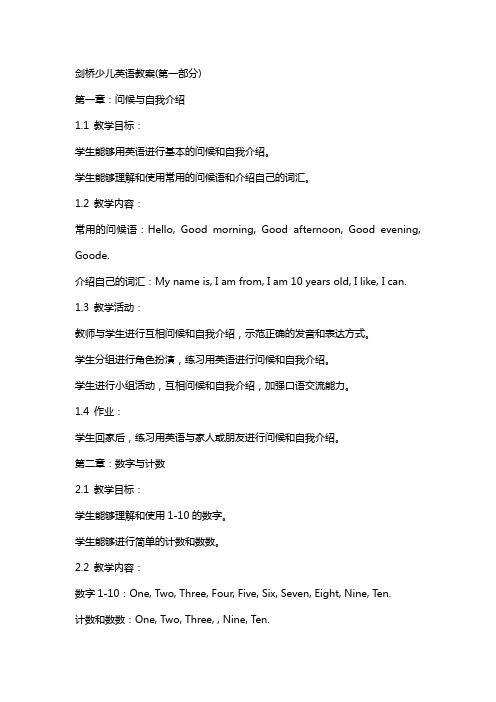
剑桥少儿英语教案(第一部分)第一章:问候与自我介绍1.1 教学目标:学生能够用英语进行基本的问候和自我介绍。
学生能够理解和使用常用的问候语和介绍自己的词汇。
1.2 教学内容:常用的问候语:Hello, Good morning, Good afternoon, Good evening, Goode.介绍自己的词汇:My name is, I am from, I am 10 years old, I like, I can. 1.3 教学活动:教师与学生进行互相问候和自我介绍,示范正确的发音和表达方式。
学生分组进行角色扮演,练习用英语进行问候和自我介绍。
学生进行小组活动,互相问候和自我介绍,加强口语交流能力。
1.4 作业:学生回家后,练习用英语与家人或朋友进行问候和自我介绍。
第二章:数字与计数2.1 教学目标:学生能够理解和使用1-10的数字。
学生能够进行简单的计数和数数。
2.2 教学内容:数字1-10:One, Two, Three, Four, Five, Six, Seven, Eight, Nine, T en.计数和数数:One, Two, Three, , Nine, Ten.2.3 教学活动:教师出示数字卡片,学生能够正确说出数字。
学生进行数数游戏,练习计数和数数。
学生分组进行数字接龙游戏,加强数字的认识和记忆。
2.4 作业:学生回家后,练习写数字1-10,并尝试进行简单的计数和数数。
第三章:颜色3.1 教学目标:学生能够理解和使用常用的颜色词汇。
学生能够描述物体的颜色。
3.2 教学内容:常用的颜色词汇:Red, Yellow, Blue, Green, White, Black, Brown, Pink, Purple, Orange.3.3 教学活动:教师出示不同颜色的物体,学生能够正确说出颜色。
学生进行颜色匹配游戏,练习识别和描述颜色。
学生分组进行颜色接力游戏,加强颜色词汇的记忆和运用。
2024年小学英语优质公开课教案通用
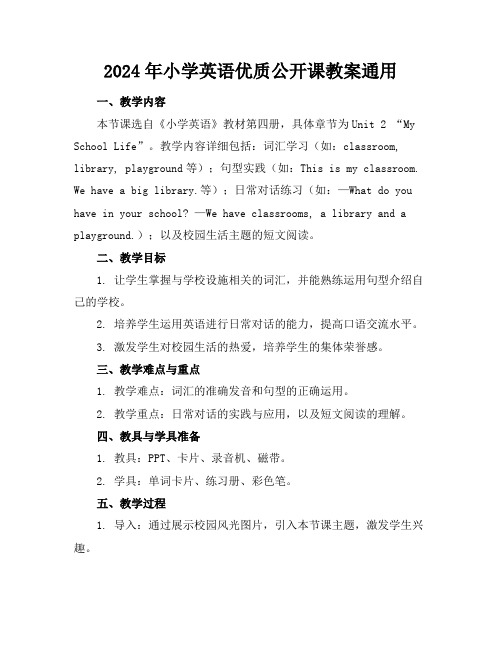
2024年小学英语优质公开课教案通用一、教学内容本节课选自《小学英语》教材第四册,具体章节为Unit 2 “My School Life”。
教学内容详细包括:词汇学习(如:classroom, library, playground等);句型实践(如:This is my classroom. We have a big library.等);日常对话练习(如:—What do you have in your school? —We have classrooms, a library and a playground.);以及校园生活主题的短文阅读。
二、教学目标1. 让学生掌握与学校设施相关的词汇,并能熟练运用句型介绍自己的学校。
2. 培养学生运用英语进行日常对话的能力,提高口语交流水平。
3. 激发学生对校园生活的热爱,培养学生的集体荣誉感。
三、教学难点与重点1. 教学难点:词汇的准确发音和句型的正确运用。
2. 教学重点:日常对话的实践与应用,以及短文阅读的理解。
四、教具与学具准备1. 教具:PPT、卡片、录音机、磁带。
2. 学具:单词卡片、练习册、彩色笔。
五、教学过程1. 导入:通过展示校园风光图片,引入本节课主题,激发学生兴趣。
2. 新课内容呈现:使用PPT展示词汇和句型,结合录音机播放标准发音,引导学生模仿跟读。
3. 实践环节:组织学生进行小组活动,用所学词汇和句型介绍自己的学校;进行角色扮演,模拟日常对话。
4. 例题讲解:结合PPT和黑板,讲解练习册中的典型题目,指导学生正确答题。
5. 随堂练习:学生独立完成练习册上的题目,教师进行个别辅导。
六、板书设计1. 词汇:classroom, library, playground, school, we, have, this, is 等。
2. 句型:This is my classroom. We have a big library.What do you have in your school? 等。
2024年少儿英语公开课教案
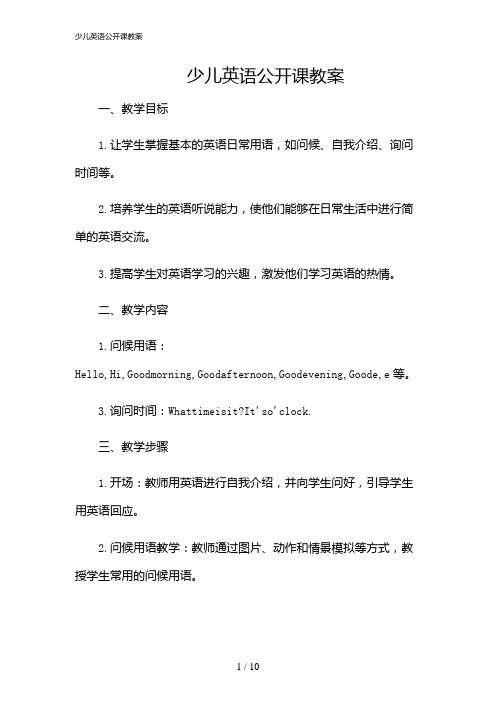
少儿英语公开课教案一、教学目标1.让学生掌握基本的英语日常用语,如问候、自我介绍、询问时间等。
2.培养学生的英语听说能力,使他们能够在日常生活中进行简单的英语交流。
3.提高学生对英语学习的兴趣,激发他们学习英语的热情。
二、教学内容1.问候用语:Hello,Hi,Goodmorning,Goodafternoon,Goodevening,Goode,e等。
3.询问时间:Whattimeisit?It'so'clock.三、教学步骤1.开场:教师用英语进行自我介绍,并向学生问好,引导学生用英语回应。
2.问候用语教学:教师通过图片、动作和情景模拟等方式,教授学生常用的问候用语。
3.自我介绍教学:教师通过自我介绍的方式,引导学生用英语进行自我介绍。
4.询问时间教学:教师通过图片和情景模拟,教授学生如何用英语询问时间。
5.单词教学:教师通过图片和实物,教授学生常用的单词。
6.练习环节:教师组织学生进行角色扮演,用英语进行问候、自我介绍和询问时间。
7.总结:教师对本次课程进行总结,强调重点内容,布置课后作业。
四、教学评价1.课堂表现:观察学生在课堂上的参与程度,回答问题的积极性等。
2.课后作业:检查学生的课后作业完成情况,了解学生对课堂内容的掌握程度。
3.口语表达:评估学生在角色扮演环节的口语表达能力,如语音、语调、流利度等。
五、教学建议1.教师应注重培养学生的英语听说能力,多组织口语练习活动。
2.教师应关注学生的学习兴趣,采用生动有趣的教学方法,提高学生的学习积极性。
3.教师应定期对学生的学习情况进行评估,及时调整教学策略,提高教学效果。
六、教学资源1.图片:用于辅助教学,帮助学生理解和记忆单词和句型。
2.实物:用于单词教学,使学生能够直观地了解所学内容。
3.录音机:用于播放英语听力材料,提高学生的听力水平。
4.教学视频:用于展示英语情景对话,帮助学生模仿和学习。
七、教学时间安排1.开场:5分钟2.问候用语教学:10分钟3.自我介绍教学:10分钟4.询问时间教学:10分钟5.单词教学:10分钟6.练习环节:15分钟7.总结:5分钟八、教学反思1.教师应关注学生的学习反馈,及时调整教学方法和教学内容。
少儿英语公开课教案

少儿英语公开课教案
一、教学目标
1. 通过公开课的形式,引导学生建立对英语学习的兴趣和积极态度。
2. 培养学生的听、说、读、写的综合能力。
3. 培养学生的英语自学能力和团队合作意识。
二、教学重点
1. 培养学生的英语语感,提高听说能力。
2. 学习并掌握一些常用的英语单词和表达方式。
3. 通过合作学习和游戏活动,激发学生的学习动力。
三、教学准备
1. 多媒体教学设备:投影仪、电脑等。
2. 学生的英语教材和练习册。
3. 学生练习所需的纸和笔。
四、教学过程
1. 开场导入(5分钟)
老师可以通过音乐和笑话等方式,营造轻松的学习氛围,并
温馨地欢迎学生参加公开课。
2. 知识讲解(20分钟)
a. 教师可通过PPT或图片展示一些常见的动物,如狗、猫、
鸟等。
并用英语与学生互动,引导他们发表自己对动物的喜好。
b. 老师再介绍一些动物的英语单词,并进行发音讲解和示范。
学生可以跟读并模仿发音。
c. 老师用简单的句子操练,引导学生运用所学动物词汇进行表达。
3. 合作学习(30分钟)
a. 将学生分成小组,每组4-5人。
b. 教师给每个小组发放一套动物卡片,并告知学生要求,在
规定时间内,尽量利用已学的动物词汇进行对话、交流。
c. 教师巡回指导,鼓励学生提问、回答和分享自己的观点。
小学英语优质公开课教案(通用14篇)

小学英语优质公开课教案〔通用14篇〕小学英语优质公开课教案〔通用14篇〕小学英语优质公开课教案篇1一、教学目的:1、掌握there be构造所表达的意义。
2、能听懂和看懂包含there be句型的简短对话。
3、能运用学过词汇和there be句型来简单描绘一下某处有某物。
二、重点难点:there be句型的肯定式、否认式一般疑问句及其答复方式。
三、教学过程:1、there be概念。
there be ...句型,表示的是“存在”,“某地有某人或某物”,其构造为there be(is,are)+某物/某人+某地。
2、be动词的用法。
单数名词和不可数名词用is,复数用are.3、there is的句子构造:there is a book on the desk.there is some water in the bottle.4、there are的句子构造:there are some pictures on the wall.小学英语优质公开课教案篇2教学目的:1.能听说、认读eye, face , ear, nose, mouth,这些关于身体部位的单词,并能用英语介绍自己身体的这几个局部2.初步理解表示接触的指示用语,能听懂,并按指令做出相应的动作。
3.激发学生学习兴趣,培养听说习惯和才能。
教学重点:关于头部的单词eye, face , ear, nose, mouth的学习。
教学难点:eye, face两个单词的元音因素容易发音不到位,老师可鼓励学生张大口型,互相检查。
mouth一词的尾音发音较难,老师可适当提醒学生,注意口型教学过程:step 1.warm up and revi-sion 1.greetings :hello,boys and girls! nice to meet you! sit down please!step 2.presentation1.利用多媒体展示学生感兴趣的动画人物“大耳朵图图”,让学生与图中人物进展口语交流let’s say “hello, tutu.”2.tu tu is so cute.look! this is tutu’s eye.并指着tutu的眼睛介绍。
少儿英语公开课教案

少儿英语公开课教案教案标题:少儿英语公开课教案教案目标:1. 帮助学生建立英语学习的兴趣和自信心。
2. 培养学生的听、说、读、写的基本英语能力。
3. 引导学生在情境中运用所学英语进行交流。
教学目标:1. 学习并掌握英语日常用语和简单句型。
2. 能够正确发音并模仿英语语音。
3. 能够通过简单的对话和问答进行基本的交流。
教学重点:1. 学习英语日常用语和简单句型。
2. 培养学生的英语听力和口语能力。
教学准备:1. 多媒体设备和教学资源。
2. 学生教材和练习册。
3. 图片、卡片或其他视觉辅助工具。
教学过程:引入(5分钟):1. 通过展示一些有趣的图片或物品引起学生的兴趣。
2. 利用问题和回答的方式激发学生对主题的思考。
导入新知(10分钟):1. 利用多媒体设备或图片展示英语日常用语和简单句型。
2. 引导学生跟读和模仿正确的发音和语调。
操练与巩固(15分钟):1. 通过角色扮演、问答游戏等形式,让学生在情境中运用所学英语进行交流。
2. 利用练习册或工作纸让学生进行书面练习。
拓展与应用(10分钟):1. 利用多媒体设备或其他资源展示一段简短的英语视频或歌曲。
2. 引导学生观看或聆听,并尝试理解其中的内容。
总结与反思(5分钟):1. 回顾本节课所学的英语日常用语和简单句型。
2. 鼓励学生分享自己的学习感受和困惑,提供必要的帮助和指导。
教学延伸:1. 布置一些与本节课内容相关的家庭作业,如练习册上的习题或口头练习。
2. 鼓励学生在日常生活中多使用英语进行交流,并提供必要的支持和鼓励。
教学评估:1. 观察学生在课堂上的表现,包括参与度、发言能力等。
2. 收集学生的书面练习和口头表达作为评估材料。
3. 根据学生的表现和反馈,及时调整教学策略和教学内容。
教学反思:1. 回顾本节课的教学过程和效果,总结教学中的成功和不足之处。
2. 根据学生的反馈和评估结果,调整教学策略和教学方法。
注:以上教案仅供参考,实际教学中应根据学生的实际情况和教学资源的具体情况进行调整和完善。
